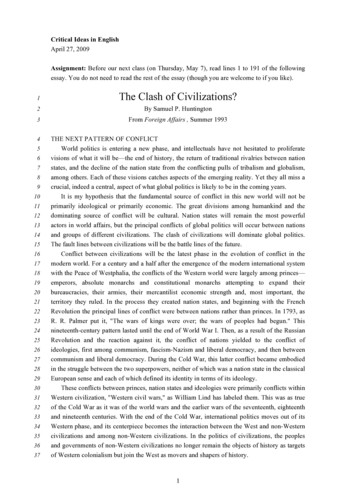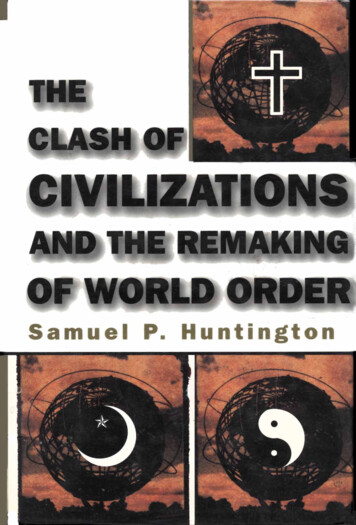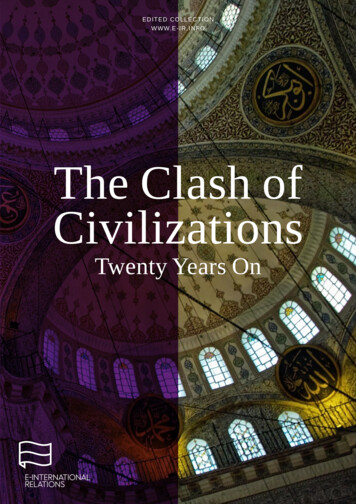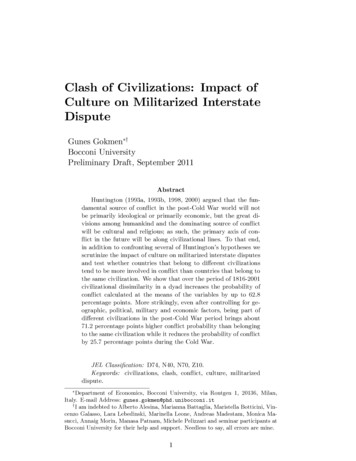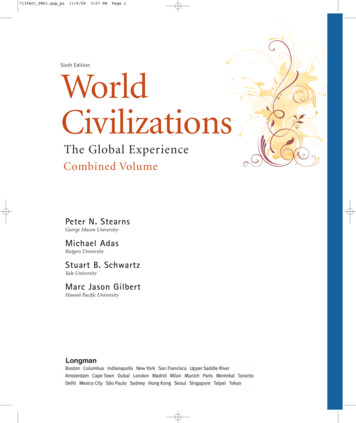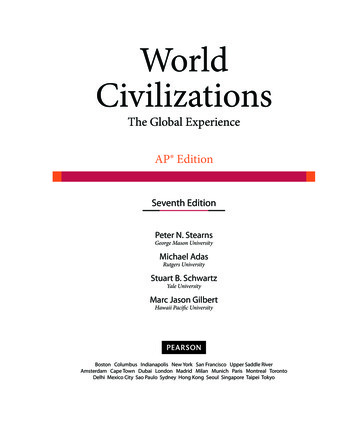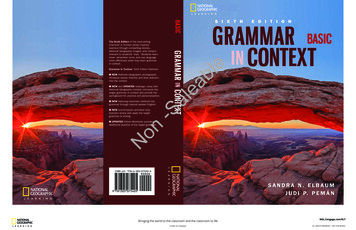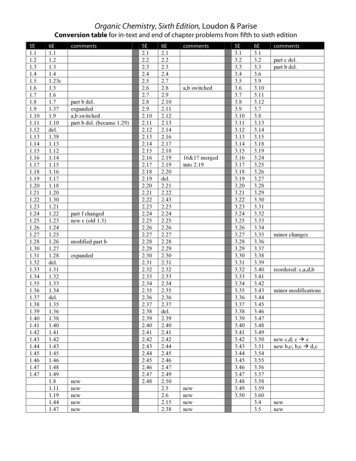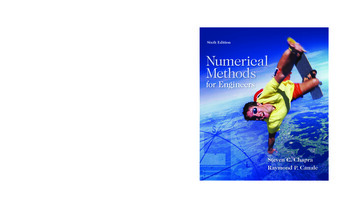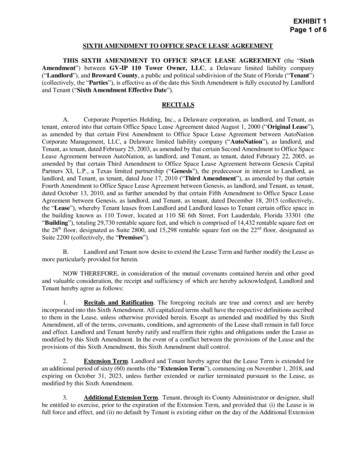
Transcription
7276A01 FM01.qxp pz11/13/0911:36 AMPage iSixth EditionWorldCivilizationsThe Global ExperienceVolume 1Peter N. StearnsGeorge Mason UniversityMichael AdasRutgers UniversityStuart B. SchwartzYale UniversityMarc Jason GilbertHawaii Pacific UniversityLongman
7276A01 FM01.qxp pz11/13/0911:36 AMPage iiEditorial Director: Craig CampanellaPublisher: Charlyce Jones OwenEditorial Assistant: Maureen DianaDirector of Marketing: Brandy DawsonSenior Marketing Manager: Maureen E. Prado RobertsSenior Managing Editor: Ann Marie McCarthyMarketing Assistant: Marissa C. O’BrienSenior Project Manager: Denise ForlowSenior Manufacturing and Operations Managerfor Arts & Sciences: Nick SklitsisOperations Specialist: Christina AmatoSenior Art Director: Maria LangeInterior Design: Jill LittleCover Designer: Jill LehanCover Art: Petros M. Nomikos/Courtesy of Thera Foundations,The Archaeological Society at AthensPhoto Researchers: Beth Brenzel and Francelle CarapetyanManager, Rights and Permissions: Zina ArabiaManager, Visual Research: Beth BrenzelManager, Cover Visual Research and Permissions: KarenSanatarImage Permissions Coordinator: Debbie HewitsonDirector of Media and Assessment: Brian HylandMedia Editor: Sarah KinneySupplements Editor: Emsal HasanFull-Service Project Management and Composition: BruceHobart/Laserwords MainePrinter/Binder: Courier/KendallvilleCover Printer: Lehigh-Phoenix Color/HagerstownText Type Face: MinionCredits and acknowledgements borrowed from other sources and reproduced, with permission, in this textbook appear onappropriate page within text (or on page C-1).Copyright 2011, 2007, 2004, 2001 Pearson Education, Inc., publishing as Longman, One Lake St., Upper Saddle River, NJ 07458.All rights reserved. Manufactured in the United States of America. This publication is protected by Copyright, and permissionshould be obtained from the publisher prior to any prohibited reproduction, storage in a retrieval system, or transmission in anyform or by any means, electronic, mechanical, photocopying, recording, or likewise. To obtain permission(s) to use material fromthis work, please submit a written request to Pearson Education, Inc., Permissions Department, One Lake St., Upper Saddle River,NJ 07458.Many of the designations used by manufacturers and sellers to distinguish their products are claimed as trademarks. Where thosedesignations appear in this book, and the publisher was aware of the trademark claim, the designations have been printed in initialor all caps.Library of Congress Cataloging-in-Publication DataWorld civilizations : the global experience / Peter N. Stearns . . . [et al.].—6th ed.p. cm.Includes bibliographical references and index.ISBN 0-205-65956-X (combined)—ISBN 0-205-65958-6 (vol. 1)—ISBN 0-205-65959-4 (vol. 2)—ISBN 0-13-136020-5 (AP edition)1. Civilization—History. 2. Civilization—History—Sources. I. Stearns, Peter N.CB69.W666 2011909—dc22200903863510 9 8 7 6 5 4 3 2 1ISBN 10: 0-205-65958-6ISBN 13: 978-0-205-65958-6
7276A01 FM01.qxp pz11/13/0911:36 AMPage iiiBrief ContentsPART IIITHE POSTCLASSICAL PERIOD, 500–1450:NEW FAITH AND NEW COMMERCE 236PART IEARLY HUMAN SOCIETIES, 2.5 MILLION–1000 B.C.E.:ORIGINS AND DEVELOPMENT 2123The Neolithic Revolution and the Birth of Civilization 10The Rise of Civilization in the Middle East and Africa 28Asia’s First Civilizations: India and China 48PART IITHE CLASSICAL PERIOD, 1000 B.C.E.–500 C.E.:UNITING LARGE REGIONS 7245678910Unification and the Consolidation of Civilization in China 80Classical Civilizations in the Eastern Mediterraneanand Middle East 102Religious Rivalries and India’s Golden Age 124Rome and Its Empire 146The Peoples and Civilizations of the Americas 164The Spread of Civilizations and the Movement of Peoples 186The End of the Classical Era: World History in Transition,200–700 C.E. 21611121314151617181920The First Global Civilization: The Rise and Spread of Islam 244Abbasid Decline and the Spread of Islamic Civilizationto South and Southeast Asia 270African Civilizations and the Spread of Islam 292Civilization in Eastern Europe: Byzantiumand Orthodox Europe 312A New Civilization Emerges in Western Europe 328The Americas on the Eve of Invasion 350Reunification and Renaissance in Chinese Civilization:The Era of the Tang and Song Dynasties 372The Spread of Chinese Civilization: Japan, Korea,and Vietnam 394The Last Great Nomadic Challenges: From Chinggis Khanto Timur 418The World in 1450: Changing Balance of World Power 438PART IVTHE EARLY MODERN PERIOD, 1450–1750:THE WORLD SHRINKS 4582122The World Economy 466The Transformation of the West, 1450–1750 486iii
7276A01 FM01.qxp pz11/13/0911:36 AMPage iv
7276A01 FM01.qxp pz11/13/0911:36 AMPage vContentsMapsCHAPTER 3 Asia’s First Civilizations: Indiaand China 48xiPreface xiiiSupplementsxixAbout the AuthorsProloguexxixxiiiPART IEARLY HUMAN SOCIETIES, 2.5 MILLION–1000 B.C.E.:ORIGINS AND DEVELOPMENT 2CHAPTER 1 The Neolithic Revolution and theBirth of Civilization 10Human Life in the Era of Hunters and Gatherers 11DOCUMENT: Tales of the Hunt: Paleolithic CavePaintings as History 15Agriculture and the Origins of Civilization:The Neolithic Revolution 17VISUALIZING THE PAST: Representations of Womenin Early Art 21The First Towns: Seedbeds of Civilization 22THINKING HISTORICALLY: The Idea of Civilizationin World Historical Perspective 24GLOBAL CONNECTIONS: The Neolithic Revolutionas the Basis for World History 26Further Readings 26On the Web 26CHAPTER 2 The Rise of Civilization in the MiddleEast and Africa 28Early Civilization in Mesopotamia 28Later Mesopotamian Civilization: A Seriesof Conquests 33VISUALIZING THE PAST: Mesopotamia in Maps 34DOCUMENT: Hammurabi’s Law Code 35Ancient Egypt 36THINKING HISTORICALLY: Women in PatriarchalSocieties 38Egypt and Mesopotamia Compared 40Civilization Centers in Africa and the EasternMediterranean 41The Issue of Heritage 44GLOBAL CONNECTIONS: The Early Civilizationsand the World 45Further Readings 45On the Web 46The Indus Valley and the Birth of South AsianCivilization 50Aryan Incursions and Early Aryan Societyin India 53DOCUMENT: Aryan Poetry in Praiseof a War Horse 56A Bend in the River and the Beginnings of China 56The Decline of the Shang and the Eraof Zhou Dominance 60THINKING HISTORICALLY: Nomadic Contactsand the Endurance of Asia’s First Civilizations 62VISUALIZING THE PAST: Mapping the Riseof Civilizations 64GLOBAL CONNECTIONS: Contrasting Legacies:Harappan and Early Chinese Civilizations 66Further Readings 66On the Web 66PART IITHE CLASSICAL PERIOD, 1000 B.C.E.–500 C.E.:UNITING LARGE REGIONS 72CHAPTER 4 Unification and the Consolidationof Civilization in China 80Philosophical Remedies for the Prolonged Crisisof the Later Zhou 81DOCUMENT: Teachings of the RivalChinese Schools 85The Triumph of the Qin and Imperial Unity 85The Han Dynasty and the Foundations of China’sClassical Age 89THINKING HISTORICALLY: Xunzi and the Shiftfrom Ritual Combat to “Real” War 90VISUALIZING THE PAST: Capital Designs and Patternsof Political Power 96GLOBAL CONNECTIONS: Classical Chinaand the World 100Further Readings 100On the Web 101CHAPTER 5 Classical Civilizations in the EasternMediterranean and Middle East 102The Persian Empire: A New Perspectivein the Middle East 104v
7276A01 FM01.qxp pzvi11/13/0911:36 AMPage viContentsThe Political Character of Classical Greece 106The Hellenistic Period 110VISUALIZING THE PAST: Political Ritualsin Persia 113Greek and Hellenistic Culture 113THINKING HISTORICALLY: Defining SocialHistory 114Patterns of Mediterranean and Middle EasternSociety 118DOCUMENT: The Power of Greek Drama 119GLOBAL CONNECTIONS: Persia, Greece,and the World 121Further Readings 122On the Web 122CHAPTER 6 Religious Rivalries and India’sGolden Age 124The Age of Brahman Dominance 125An Era of Widespread Social Change 127THINKING HISTORICALLY: Inequalityas a Social Norm 129Religious Ferment and the Rise of Buddhism 132The Rise and Decline of the Mauryas 134Brahmanical Recovery and the Splendorsof the Gupta Age 136VISUALIZING THE PAST: The Pattern of Tradein the Ancient Eurasian World 138Intensifying Caste and Gender Inequitiesand Gupta Decline 141DOCUMENT: A Guardian’s Farewell Speech to a YoungWoman About to Be Married 142GLOBAL CONNECTIONS: India and the WiderWorld 143Further Readings 144On the Web 144CHAPTER 7 Rome and Its Empire 146The Development of Rome’s Republic 147Roman Culture 151DOCUMENT: Rome and a Values Crisis 153How Rome Ruled Its Empire 153VISUALIZING THE PAST: Religions in Rome 156The Evolution of Rome’s Economicand Social Structure 156THINKING HISTORICALLY: The Classical Civilizationsin Comparative Perspective 158The Origins of Christianity 159The Decline of Rome 161GLOBAL CONNECTIONS: Rome and the World162Further Readings 162On the Web 163CHAPTER 8 The Peoples and Civilizationsof the Americas 164Origins of American Societies 166Spread of Civilization in Mesoamerica 171DOCUMENT: Deciphering the Maya Glyphs 175THINKING HISTORICALLY: Different Timesfor Different Peoples 176The Peoples to the North 177The Andean World 180VISUALIZING THE PAST: Ancient Agriculture 183GLOBAL CONNECTIONS: American Civilizationsand the World 184Further Readings 184On the Web 185CHAPTER 9 The Spread of Civilizationsand the Movement of Peoples 186The Spread of Civilization in Africa 188DOCUMENT: Myths of Origin 194THINKING HISTORICALLY: Language as a HistoricalSource 198Nomadic Societies and Indo-EuropeanMigrations 198VISUALIZING THE PAST: Varieties of HumanAdaptation and the Potential for Civilization 204The Spread of Chinese Civilization to Japan 204Political and Social Change 208The Scattered Societies of Polynesia 209GLOBAL CONNECTIONS: The Emerging Cultures 214Further Readings 214On the Web 215CHAPTER 10 The End of the Classical Era: WorldHistory in Transition, 200–700 C.E. 216Upheavals in Eastern and Southern Asia 217DOCUMENT: The Popularization of Buddhism 219The Decline and Fall of the Roman Empire 221THINKING HISTORICALLY: The Problem of Declineand Fall 225The Development and Spread of WorldReligions 226VISUALIZING THE PAST: Religious Geography 229GLOBAL CONNECTIONS: The Late Classical Periodand the World 230
7276A01 FM01.qxp pz11/13/0911:36 AMPage viiContentsFurther Readings 230On the Web 231PART IIITHE POSTCLASSICAL PERIOD, 500–1450:NEW FAITH AND NEW COMMERCE 236CHAPTER 11 The First Global Civilization:The Rise and Spread of Islam 244Desert and Town: The Pre-IslamicArabian World 245The Life of Muhammad and the Genesisof Islam 250The Arab Empire of the Umayyads 253THINKING HISTORICALLY: Civilization and GenderRelationships 260From Arab to Islamic Empire: The EarlyAbbasid Era 262VISUALIZING THE PAST: The Mosque as a Symbolof Islamic Civilization 264DOCUMENT: The Thousand and One Nightsas a Mirror of Elite Society in the AbbasidEra 266GLOBAL CONNECTIONS: Early Islamand the World 267Further Readings 268On the Web 268CHAPTER 12 Abbasid Decline and the Spreadof Islamic Civilization to South and SoutheastAsia 270The Islamic Heartlands in the Middleand Late Abbasid Eras 271DOCUMENT: Ibn Khaldun on the Rise and Declineof Empires 276An Age of Learning and Artistic Refinements 276The Coming of Islam to South Asia 280VISUALIZING THE PAST: The Patterns of Islam’sGlobal Expansions 281THINKING HISTORICALLY: Conversionand Accommodation in the Spreadof World Religions 286The Spread of Islam to Southeast Asia 288GLOBAL CONNECTIONS: Islam: A BridgeBetween Worlds 290Further Readings 290On the Web 290CHAPTER 13 African Civilizations and the Spreadof Islam 292African Societies: Diversity and Similarities 293Kingdoms of the Grasslands 297DOCUMENT: The Great Oral Tradition and the Epicof Sundiata 300VISUALIZING THE PAST: The Architectureof Faith 303The Swahili Coast of East Africa 303Peoples of the Forest and Plains 305THINKING HISTORICALLY: Two Transitionsin the History of World Population 306GLOBAL CONNECTIONS: Internal Developmentand Global Contacts 310Further Readings 310On the Web 311CHAPTER 14 Civilization in Eastern Europe:Byzantium and Orthodox Europe 312Civilization in Eastern Europe 312The Byzantine Empire 314VISUALIZING THE PAST: Women and Powerin Byzantium 317The Split Between Eastern and WesternChristianity 318THINKING HISTORICALLY: Eastern and WesternEurope: The Problem of Boundaries 321The Spread of Civilization in Eastern Europe 321The Emergence of Kievan Rus’ 323DOCUMENT: Russia Turns to Christianity 324GLOBAL CONNECTIONS: Eastern Europeand the World 326Further Readings 326On the Web 326CHAPTER 15 A New Civilization Emergesin Western Europe 328Stages of Postclassical Development 329VISUALIZING THE PAST: Peasant Labor 331DOCUMENT: European Travel: A MonkVisits Jerusalem 337THINKING HISTORICALLY: Western Civilization 339Western Culture in the Postclassical Era 340Changing Economic and Social Formsin the Postclassical Centuries 342The Decline of the Medieval Synthesis 346GLOBAL CONNECTIONS: Medieval Europeand the World 348vii
7276A01 FM01.qxp pzviii11/13/0911:36 AMPage viiiContentsFurther Readings 349On the Web 349CHAPTER 16 The Americas on the Eveof Invasion 350Postclassic Mesoamerica, 1000–1500 C.E. 351Aztec Society in Transition 357DOCUMENT: Aztec Women and Men 359Twantinsuyu: World of the Incas 360VISUALIZING THE PAST: Archeological Evidenceof Political Practices 362THINKING HISTORICALLY: The “Troubling”Civilizations of the Americas 364The Other Peoples of the Americas 367GLOBAL CONNECTIONS: The Americasand the World 370Further Readings 370On the Web 370CHAPTER 17 Reunification and Renaissancein Chinese Civilization: The Era of the Tangand Song Dynasties 372Rebuilding the Imperial Edificein the Sui-Tang Era 373DOCUMENT: Ties That Bind: Paths to Power 378Tang Decline and the Rise of the Song 380Tang and Song Prosperity: The Basisof a Golden Age 384VISUALIZING THE PAST: Footbinding as a Markerof Male Dominance 388THINKING HISTORICALLY: Artistic Expressionand Social Values 390GLOBAL CONNECTIONS: China’s World Role 392Further Readings 392On the Web 393CHAPTER 18 The Spread of Chinese Civilization:Japan, Korea, and Vietnam 394Japan: The Imperial Age 395The Era of Warrior Dominance 400THINKING HISTORICALLY: ComparingFeudalisms 402Korea: Between China and Japan 406Between China and Southeast Asia: The Makingof Vietnam 409VISUALIZING THE PAST: What Their Portraits Tell Us:Gatekeeper Elites and the Persistenceof Civilizations 412DOCUMENT: Literature as a Mirror of the ExchangesBetween Civilized Centers 415GLOBAL CONNECTIONS: In the Orbit of China: TheEast Asian Corner of the Global System 415Further Readings 416On the Web 416CHAPTER 19 The Last Great Nomadic Challenges:From Chinggis Khan to Timur 418The Transcontinental Empire of Chinggis Khan 420DOCUMENT: A European Assessment of the Virtuesand Vices of the Mongols 424The Mongol Drive to the West 426VISUALIZING THE PAST: The Mongol Empireas a Bridge Between Civilizations 429The Mongol Interlude in Chinese History 430THINKING HISTORICALLY: The Global Eclipseof the Nomadic Warrior Culture 434GLOBAL CONNECTIONS: The Mongol Linkages 436Further Readings 437On the Web 437CHAPTER 20 The World in 1450: ChangingBalance of World Power 438Key Changes in the Middle East 439The Rise of the West 442VISUALIZING THE PAST: Population Trends 443DOCUMENT: Bubonic Plague 444Western Expansion: The Experimental Phase 447Outside the World Network 448THINKING HISTORICALLY: The Problemof Ethnocentrism 450GLOBAL CONNECTIONS: 1450 and the World 451Further Readings 451On the Web 452PART IVTHE EARLY MODERN PERIOD, 1450–1750:THE WORLD SHRINKS 458CHAPTER 21 The World Economy466The West’s First Outreach: Maritime Power 466THINKING HISTORICALLY: Causation and the West’sExpansion 471Toward a World Economy 472VISUALIZING THE PAST: West IndianSlaveholding 475
7276A01 FM01.qxp pz11/13/0911:36 AMPage ixContentsColonial Expansion 477DOCUMENT: Western Conquerors: Tacticsand Motives 478GLOBAL CONNECTIONS: The World Economy—And the World 483Further Readings 484On the Web 484CHAPTER 22 The Transformation of the West,1450–1750 486The First Big Changes: Culture and Commerce,1450–1650 487The Commercial Revolution 492The Scientific Revolution: The Next Phaseof Change 495VISUALIZING THE PAST: Versailles497Political Change 497THINKING HISTORICALLY: Elites and Masses 498The West by 1750 500DOCUMENT: Controversies About Women 501GLOBAL CONNECTIONS: Europe and the World 504Further Readings 504On the Web 505Glossary G-1CreditsIndexC-1I-1ix
7276A01 FM01.qxp pz11/13/0911:36 AMPage x
7276A01 FM01.qxp pz11/13/0911:36 AMPage xiMaps10.4 Major Religions of the Modern World229PART III Spread of Buddhism, Christianity, and Islamto c. 1450 239PART III Main Routes of Afro-Eurasian Trade, c. 1250PART I Initial Centers and Spread of Agriculture 5PART I Early Centers of Civilization 51.11.22.12.22.32.43.13.23.33.43.5The Spread of Human Populations, c. 10,000 B.C.E.The Spread of Agriculture 19Early Sumer 29Mesopotamia in Maps 34Egypt, Kush, and Axum, Successive Dynasties 37The Eastern Mediterranean, c. 1100 B.C.E. 42India in the Age of Harappa and the EarlyAryan Migrations 51China in the Shang and Zhou Eras 57Harappan South Asia 64Ancient Egypt in the Middle of the SecondMillennium B.C.E. 65Core Regions of Chinese Civilization 65PART II Political Units of the World, c. 800–750 B.C.E.PART II Political Units of the World, c. 1–100 .28.39.19.29.39.49.59.69.710.110.210.3147575The Era of Nomadic Incursions and Warring States 82China from the Later Zhou Era to the Han Era 86Ancient Capitals 96The Persian Empire in Its Main Stages 104The Greek World 107Greece and Greek Colonies of the World, c. 431 B.C.E. 109Alexander’s Empire and the Hellenistic World,c. 323 B.C.E. 112India at the Time of Ashoka 126The Spread of Buddhism in Asia, 400 B.C.E.–600 C.E. 137Eurasian and African Trading Goods and Routes,c. 300 B.C.E. to 300 C.E. 139The Gupta Empire 140The Expansion of the Roman Republic, 133 B.C.E. 150The Roman Empire from Augustus to 180 C.E. 155Origins and Early Spread of Christianity,to 4th–5th Century 160Civilizations of Central and South America 169Mesoamerican Settlements 171Andean Societies 181Africa: Variations in Climate 189Bantu Migrations 193West African States 197Germanic and Slavic Peoples on the Move, 375–450 C.E. 203East Asia at the End of the Classical Period 206The Rise of Japanese Civilization 207The Spread of Polynesian Peoples 210Asia, c. 600 C.E. 218Indian Ocean Trading Routes in the Classical Period 221Germanic Kingdoms After the Invasions 22323911.1 Arabia and Surrounding Areas Before and Duringthe Time of Muhammad 24711.2 The Expansion of the Islamic Empire in the 7thand 8th Centuries 25611.3 Emergence of the Abbasid Dynasty 26212.1 The Abbasid Empire at Its Peak 27212.2 The Spread of Islam, 10th–16th Centuries 27812.3 Early Islam in India 28212.4 The Spread of Islam in Southeast Asia 28913.1 Empires of the Western Sudan 29813.2 The Swahili Coast; African Monsoon Routes and MajorTrade Routes 30414.1 The Byzantine Empire Under Justinian 31614.2 The Byzantine Empire, 1000–1100 32014.3 East European Kingdoms and Slavic Expansion,c. 1000 32215.1 Charlemagne’s Empire and Successor States 33215.2 Western Europe Toward the End of the Middle Ages,c. 1360 C.E. 33615.3 Leading Trade Routes Within Europeand to the Mediterranean 34316.1 Central Mexico and Lake Texcoco 35416.2 Inca Expansion 36116.3 The Ancient Cities of Peru 36317.1 China During the Age of Division 37417.2 The Sui Dynasty and the Tang Dynasty 37517.3 China in the Song and Southern SongDynastic Periods 38218.1 Key Centers of Civilization in East Asiain the First Millennium C.E. 39618.2 Japan in the Imperial and Warlord Periods 39718.3 The Korean Peninsula During the Three Kingdoms Era 40618.4 South China and Vietnam on the Eveof the Han Conquest 40919.1 The Transcontinental Empire of Chinggis Khan 41919.2 The Four Khanates of the Divided Mongol Empire 42619.3 The Mongol Empire and the GlobalExchange Network 42920.1 Polynesian Expansion 449PART IV Major Political Units of the World, c. 1450461PART IV Major Political Units of the World, c. 175046121.1 Spain and Portugal: Explorations and Colonies 46921.2 French, British, and Dutch Holdings, c. 1700 47222.1 Western Europe During the Renaissanceand Reformation 49022.2 Europe Under Absolute Monarchy, 1715 49322.3 European Population Density, c. 1600 494xi
7276A01 FM01.qxp pz11/13/0911:36 AMPage xii
7276A01 FM01.qxp pz11/13/0911:36 AMPage xiiiPrefaceWorld history explores the human past, around the globe, to help usunderstand the world we live in today. It seeks to identify howmajor forces have developed over time, like patterns of migration orworld trade. It explores the cultures and political institutions of different regions, to help explain commonalities and differences.World history builds on a growing amount of historical scholarship,some of which has truly altered the picture of the past. It involves arich array of stories and examples of human variety, intriguing inthemselves. It helps develop skills that are vital not just to the history classroom, but to effective operation in a global society—skillslike comparing different societies, appreciating various viewpoints,identifying big changes and continuities in the human experience.Always, however, it uses the past as a prologue to the present. Worldhistorians argue that no one society, past or present, can be understood without reference to other societies and to larger globalforces. They argue, even more vigorously, that the present—whichclearly involves relationships that embrace the whole world—cannot be grasped without a sense of the global historical record.From its first edition, World Civilizations: The Global Experience has aimed at capturing a truly global approach by discussingand comparing major societies and focusing on their interactions.The goal is to present a clear factual framework while stimulatinganalysis about global contacts, regional patterns, and the wholeprocess of change and continuity on a world stage. This kind ofworld history, focused on the development over time of the forcesthat shape the world today, helps students make sense of the present and prepare to meet the challenges of the future. It is hard toimagine a more important topic.Embracing the whole world’s history obviously requires selectivity and explicit points of emphasis. This text gains coherencethrough decisions about time, about place and about topic. In allthree cases, the book encourages analysis, relating facts to vital issues of interpretation. Through analysis and interpretation students become active, engaged learners, rather than serving aspassive vessels for torrents of historical facts. Underpinning analysis, the issues of time, place, and topic are the three keys to an intelligible global past.Decisions about Time: PeriodizationThis text pays a great deal of attention to periodization, or theidentification of major points of change in the global experience.This is an essential requirement for coherent presentation—goingwell beyond the one-thing-after-another type of chronology—andultimately a precondition of relating the past to the present.World Civilizations: The Global Experience identifies six periods in world history. Each period is determined by three basic criteria: a geographical rebalancing among major civilizational areas,an increase in the intensity and extent of contact across civilizations (or, in the case of the earliest period, cross-regional contact),and the emergence of new and roughly parallel developments inmany major civilizations. The book is divided into six parts corresponding to these six major periods of world history. In each part,basic characteristics of each period are referred to in chapters thatdiscuss the major societies in the Middle East, Africa, Asia, Europeand the Americas, and in several cross-cutting chapters that address larger world trends. Each period offers a distinctive set ofthemes, or Big Concepts, that are defined in general terms andthen explored in terms of particular regions. Part introductionsidentify the fundamental new characteristics and new levels of interaction that define each period.Part I, Early Human Societies, 2.5 Million–1000 B.C.E.: Originsand Development, sketches the hunting-and-gathering phase ofhuman existence, then focuses on the rise of agriculture and theemergence of civilization in parts of Asia, Africa, Central America,and southeastern Europe—the sequence of developments that setworld history in motion from the origin of the human speciesuntil about 3000 years ago.Part II, The Classical Period, 1000 B.C.E.–500 C.E.: UnitingLarge Regions, deals with the growing complexity of major civilizations in several areas of the world. During the classical period,civilizations developed a new capacity to integrate large regionsand diverse groups of people through overarching cultural andpolitical systems. Yet many regions and societies remained unconnected to the increasingly complex centers of civilization. Coverage of the classical period of world history, then, must considerboth types of societies.The period covered in Part III, The Postclassical Period,500–1450: New Faith and New Commerce, saw the emergence ofnew commercial and cultural linkages that brought most civilizations into contact with one another and with nomadic groups.The decline of the great classical empires, the rise of new civilizational centers, and the emergence of a network of world contacts,including the spread of major religions, are characteristics of thepostclassical era.Developments in world history over the three centuries from1450 to 1750 mark a fourth period in world history, which is covered in Part IV, The Early Modern Period, 1450–1750: The WorldShrinks. The rise of the West, the intensification of global contacts,the growth of trade, and the formation of new empires define thisperiod and separate it from the preceding postclassical period.Part V, The Dawn of the Industrial Age, 1750–1914, covers theperiod of world history dominated by the advent of industrialization in western Europe and growing European imperialism. Theincrease and intensification of commercial interchange, technological innovations, and cultural contacts all reflected the growthof Western power and the spread of Western influence.The Newest Stage of World History: 1914–Present, the focus ofPart VI, defines the characteristics of this period as the retreat ofWestern imperialism, the rise of new political systems such ascommunism, the surge of the United States and the Soviet Union,and a variety of economic innovations, including the achievements of Japan, China, Korea, and the Pacific Rim. Part VI dealswith this most recent period of world history and some of its portents for the future.xiii
7276A01 FM01.qxp pzxiv11/13/0911:36 AMPage xivPrefaceUnderlying IssuesTwo related themes and one standard historical complexity riseabove the six-stage world history periodization. The first involvesthe interaction between tradition and change—and in recent periods, modern change. Many societies established key ideas and institutions early on, at least by the classical period. These traditionswould then condition responses to change and modernity. Elements of this interplay become visible from the post-classical period onward; the tradition-change encounter remains vivid in the21st century, though in forms very different from a thousandyears ago. Each world history period involves important shifts inthe interaction between change and tradition.Theme two involves divergence and convergence. Societiesemerged separately in many parts of the world, though the processwas almost always affected by some wider contacts. This is part ofthe first phase of the human experience. Separation, or divergence, did not always mean difference, for many societies solvedkey problems in similar ways; but it did tend to produce separateidentities. With growing contacts over time, opportunities andpressures produced various forms of imitation and convergence.The interplay between divergence and convergence is lively in the21st century, but its shape has changed greatly over time. Here,too, each period involves a different statement of the balance between divergence and convergence.Periodization emphasizes change, including changes in thebasic frameworks in which traditions interacted with new forcesand in which separate identities confronted new levels of convergence. Always, however, change must be complicated by recognition of key continuities from the past. At various points inhuman history, including recently, huge new forces prompt somepeople to claim that “everything has changed.” In fact, strongtraces of the past always linger. The challenge is to figure out howthe balance works.Place: Regions and CivilizationsUsable world history requires decisions about coherence in placeas well as time. Even in the present day, and certainly in the past,key developments did not occur evenly across the whole globe: regional conditions always come into play. At the same time, notevery definable society can be encompassed—early hunting-andgathering bands of humans, after all, could number no more thansixty people. No world history survey can even approach that levelof detail. World history seeks legitimate ways to define larger regions and societies that serve as the basis for meaningful contactsand reactions to global forces.Major regions of the world depend on a combination of geography and historical developments in the form of shared institutions and beliefs. This book uses several regions as frameworksfor discussing patterns of activity and larger interactions: EastAsia; South and Southeast Asia; the Middle East, ultimately withthe addition of North Africa; sub-Saharan Africa; Europe, oftenwith some division between eastern and western; and the Ameri-cas. Australia and key island groups, and also patterns in centralAsia, must be added in as well.In several regions, begi
iii PART I EARLY HUMAN SOCIETIES, 2.5 MILLION-1000 B.C.E.: ORIGINS AND DEVELOPMENT 2 1 The Neolithic Revolution and the Birth of Civilization 10 2 The Rise of Civilization in the Middle East and Africa 28 3 Asia's First Civilizations: India and China 48 PART II THE CLASSICAL PERIOD, 1000 B.C.E.-500 C.E.: UNITING LARGE REGIONS 72 4 Unification and the Consolidation of Civilization in China 80
